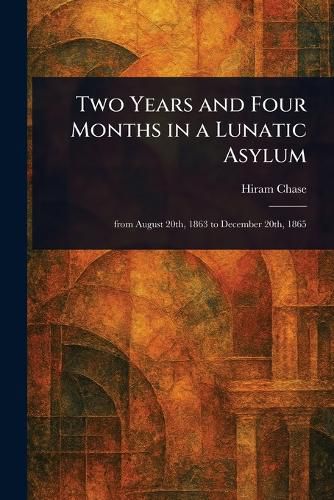Readings Newsletter
Become a Readings Member to make your shopping experience even easier.
Sign in or sign up for free!
You’re not far away from qualifying for FREE standard shipping within Australia
You’ve qualified for FREE standard shipping within Australia
The cart is loading…






This title is printed to order. This book may have been self-published. If so, we cannot guarantee the quality of the content. In the main most books will have gone through the editing process however some may not. We therefore suggest that you be aware of this before ordering this book. If in doubt check either the author or publisher’s details as we are unable to accept any returns unless they are faulty. Please contact us if you have any questions.
"Two Years and Four Months in a Lunatic Asylum" offers a compelling and unflinching firsthand account of mental illness and institutionalization in the 19th century. Authored by Hiram Chase, this powerful memoir chronicles his experiences as a patient within a lunatic asylum from August 20th, 1863, to December 20th, 1865.
Chase's writing provides a valuable historical perspective on the treatment of the mentally ill during this era. Explore the daily realities, challenges, and personal struggles faced by individuals confined within the walls of the asylum. This carefully republished edition allows readers to engage directly with an important historical document, offering insights into the social work and medical practices surrounding mental health in 19th-century America. "Two Years and Four Months in a Lunatic Asylum" stands as a testament to the enduring human spirit and the importance of understanding the patient experience.
This work has been selected by scholars as being culturally important, and is part of the knowledge base of civilization as we know it.
This work is in the public domain in the United States of America, and possibly other nations. Within the United States, you may freely copy and distribute this work, as no entity (individual or corporate) has a copyright on the body of the work.
Scholars believe, and we concur, that this work is important enough to be preserved, reproduced, and made generally available to the public. We appreciate your support of the preservation process, and thank you for being an important part of keeping this knowledge alive and relevant.
$9.00 standard shipping within Australia
FREE standard shipping within Australia for orders over $100.00
Express & International shipping calculated at checkout
Stock availability can be subject to change without notice. We recommend calling the shop or contacting our online team to check availability of low stock items. Please see our Shopping Online page for more details.
This title is printed to order. This book may have been self-published. If so, we cannot guarantee the quality of the content. In the main most books will have gone through the editing process however some may not. We therefore suggest that you be aware of this before ordering this book. If in doubt check either the author or publisher’s details as we are unable to accept any returns unless they are faulty. Please contact us if you have any questions.
"Two Years and Four Months in a Lunatic Asylum" offers a compelling and unflinching firsthand account of mental illness and institutionalization in the 19th century. Authored by Hiram Chase, this powerful memoir chronicles his experiences as a patient within a lunatic asylum from August 20th, 1863, to December 20th, 1865.
Chase's writing provides a valuable historical perspective on the treatment of the mentally ill during this era. Explore the daily realities, challenges, and personal struggles faced by individuals confined within the walls of the asylum. This carefully republished edition allows readers to engage directly with an important historical document, offering insights into the social work and medical practices surrounding mental health in 19th-century America. "Two Years and Four Months in a Lunatic Asylum" stands as a testament to the enduring human spirit and the importance of understanding the patient experience.
This work has been selected by scholars as being culturally important, and is part of the knowledge base of civilization as we know it.
This work is in the public domain in the United States of America, and possibly other nations. Within the United States, you may freely copy and distribute this work, as no entity (individual or corporate) has a copyright on the body of the work.
Scholars believe, and we concur, that this work is important enough to be preserved, reproduced, and made generally available to the public. We appreciate your support of the preservation process, and thank you for being an important part of keeping this knowledge alive and relevant.